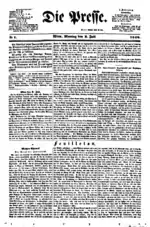August Zang
August Zang (German: [tsaŋ]; 2 August 1807 – 4 March 1888) was a nineteenth-century Austrian entrepreneur who founded the Viennese daily Die Presse. He also had a major influence on French baking methods.
August Zang | |
|---|---|
| Born | 2 August 1807 Vienna, Austria |
| Died | 4 March 1888 (aged 80) |
| Occupation | Baker, entrepreneur, soldier |
| Known for | Influence in French baking |
Soldier and baker

Son of Christophe Boniface Zang, a Vienna surgeon, August Zang became an artillery officer before going to Paris (probably in 1837) to found a bakery, Boulangerie Viennoise, which opened in 1838 or 1839.[1] The bakery was quickly imitated and its Austrian kipfel became the French croissant. Baking historians (who often qualify Zang as "Baron", "Count" or "Royal Chamberlain", though he did not hold these titles) sometimes claim he introduced the baguette, but this is not supported by any period source. He did however introduce the Viennese steam oven, which became standard in France.
Journalist and publisher

In 1848, when censorship was lifted in Austria, he returned to Vienna and founded Die Presse, a daily newspaper which still exists today (though after several interruptions). The paper was modeled on Émile de Girardin's La Presse and introduced many of the same popularizing journalistic techniques, including a low price (supported by volume and advertising), serials and short, easily understood paragraphs. In 1864, a dispute led two key journalists to leave Die Presse and found Die Neue Freie Presse. The original Die Presse was soon known as The Old Press and in 1867 Zang sold it.
Later years
In his remaining years he owned a bank and a mine in Styria, the site of which is still known today as Zangtal ("Zang Valley"). When he died, he was most known as a wealthy press magnate; his obituary in Die Presse said only that he had spent some years in Paris, omitting all mention of his role in baking. His ornate tomb in Vienna is still a tourist attraction.
See also
- Vienna bread
- Viennoiserie, a French term referring to baked goods in the style of or influenced by Viennese baking
Notes
- The 1839 date, and most of what follows regarding Zang's role in baking, is documented in Jim Chevallier, "August Zang and the French Croissant: How Viennoiserie Came to France", p. 3–30; for the 1838 date, see Giles MacDonogh "Reflections on the Third Meditation of La Physiologie du goût and Slow Food" Archived 2016-03-03 at the Wayback Machine (p. 8); an Austrian PowerPoint – Ess-Stile – gives the date of 1840 (slide 46). The bakery itself later claimed to have been founded in this year, but earlier references are documented.
References
- Wurzbach, C. (1891). Biographisches Lexikon des Kaiserthums Oesterreich, enthaltend die Lebensskizzen der denkwürdigen Perosnen, welche seit 1750 in den österreichischen Kronländern geboren wurden oder darin gelebt und gewirkt haben, (162-165)
- Article in "Die Presse" on its founding
- Another article in "Die Presse" on its founding
- Central Cemetery Zentralfriedhof-image of Zang's tomb
- Voitsberg page mentioning Zang's castle and Zangtal
- August Zang and the French Croissant